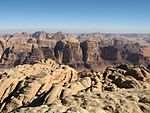This article lists the sites registered with World Heritage in Jordan.
Understand
The Jordan ratify the Convention for the Protection of the World Cultural and Natural Heritage on . The first protected site was inscribed in 1981.
The Jordan has 5 sites registered with World Heritage, 4 cultural and 1 mixed.
The country has also submitted 15 sites to the Tentative List, 12 cultural, 1 natural and 2 mixed.
Listing
The following sites are listed as World Heritage.
| Site | Type | Criterion | Description | Drawing | |||||||||||||||||||||
|---|---|---|---|---|---|---|---|---|---|---|---|---|---|---|---|---|---|---|---|---|---|---|---|---|---|
| 1 Petra | Cultural | (i), (iii), (iv) | Inhabited since prehistoric times, this Nabataean caravan city located between the Red Sea and the Dead Sea was in Antiquity an important crossroads between Arabia, Egypt and Syria-Phenicia. Half-built and half-carved in the rock inside a mountain cirque pierced with corridors and parades, Petra is one of the most famous archaeological sites, where the influences of ancient oriental traditions and architecture mingle. Hellenistic. |  | |||||||||||||||||||||
| 2 Qusair Amra | Cultural | (i), (iii), (iv) | Built at the start of the 8th century, this particularly well-preserved desert castle was both a fortress housing a garrison and a residence for the Umayyad caliphs. Endowed in particular with a courtroom and a hammam with rich figurative murals, this small pleasure castle reflects the secular art of the time. |  | |||||||||||||||||||||
| 3 Um er-Rasas | Cultural | (i), (iv), (vi) | Much of the Um er-Rasas archaeological site has yet to be excavated. The site, which includes remains from the Roman, Byzantine and early Islamic periods (late 3rd to 9th centuries AD), was first a Roman military camp and then expanded to become a city from the 5th century. The fortified military camp has been little excavated. The site also has 16 churches, some of which have well-preserved mosaic floors, in particular that of Saint Stephen's Church which represents towns in the region. Two square towers are probably the only testimonies of the practice, well known in this part of the world, of the Stylite anchorites (ascetic monks who isolated themselves at the top of a column or a tower). Remnants of ancient agricultural activities dot the Um er-Rasas site and its surroundings. |  | |||||||||||||||||||||
| 4 Old City of Jerusalem and its Walls | Cultural | (ii), (iii), (vi) | Holy city of Judaism, Christianity and Islam, Jerusalem has always had symbolic value. Among its 220 historical monuments, stands out the formidable Dome of the Rock, built in the 7th century and decorated with beautiful geometric and floral motifs. It is recognized by all three religions as the place of Abraham's sacrifice. The Western Wall serves as a limit for the quarters of the different religious communities, while the Rotunda of the Resurrection houses the tomb of Christ. |  | |||||||||||||||||||||
| 5 Wadi Rum Protected Area | Mixed | (iii), (v), (vii) | This covering good 74,000 hectares, listed as a mixed natural and cultural site, is located south of the Jordan, near the border withSaudi Arabia. It is a very spectacular desert landscape, with canyons, natural arches, cliffs, ramps and caves. The presence of petroglyphs, engraved inscriptions and archaeological remains testify to 12,000 years human occupation and interaction with the natural environment. The combination of 25,000 petroglyphs and of 20,000 registrations traces the evolution of human thought and the beginnings of alphabetic writing. The site illustrates the evolution of pastoral, agricultural and urban activities in the region. |  | |||||||||||||||||||||
Criteria legend
| |||||||||||||||||||||||||
